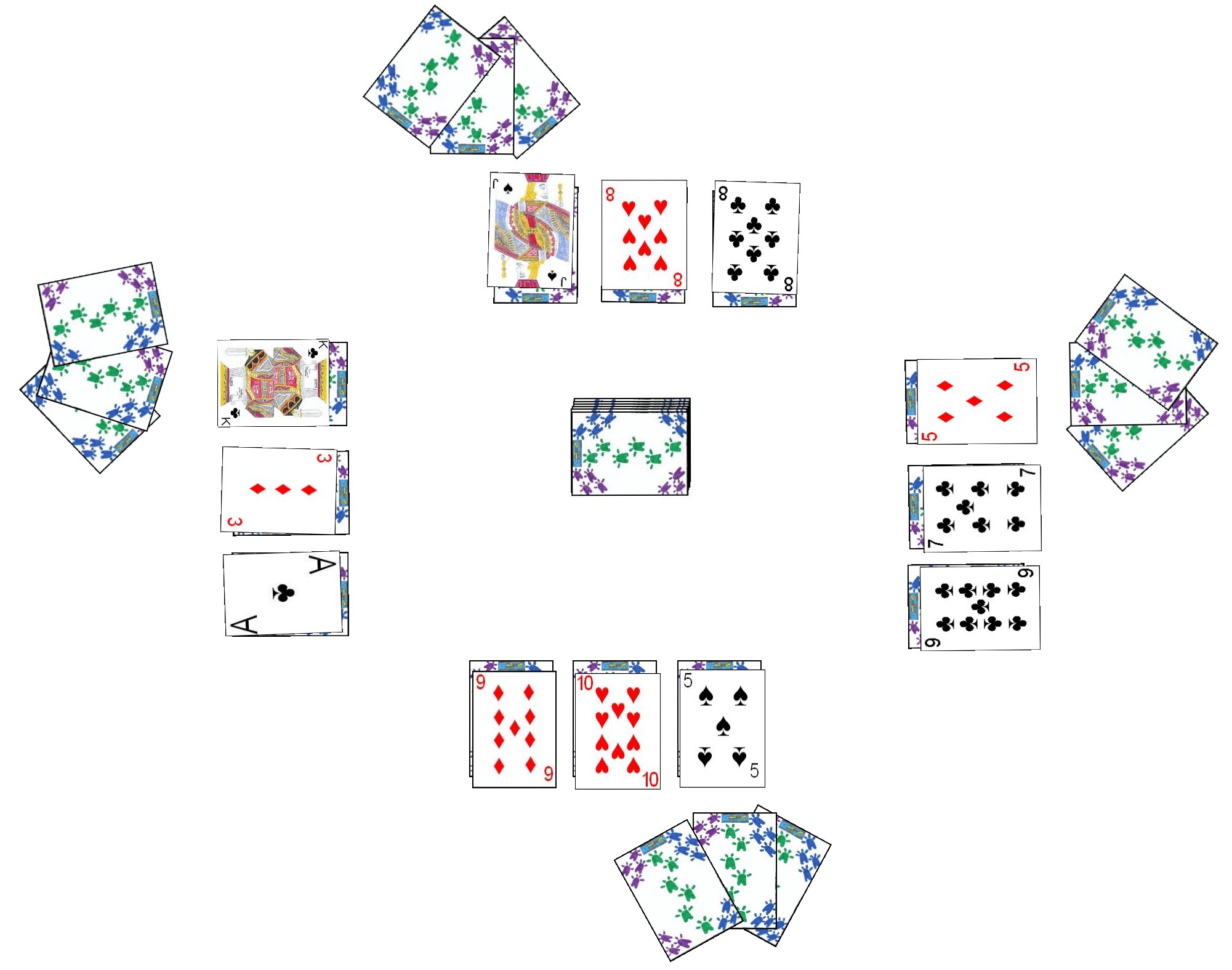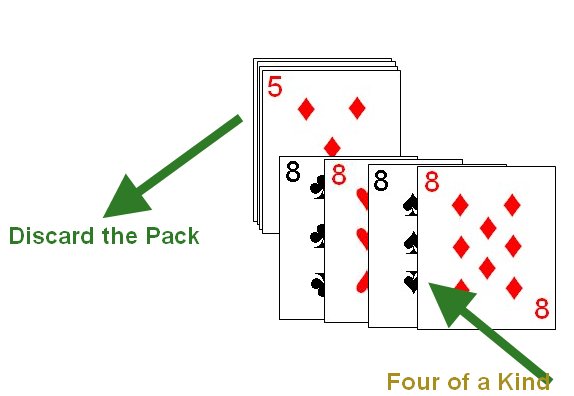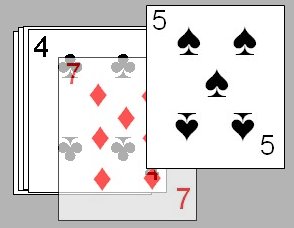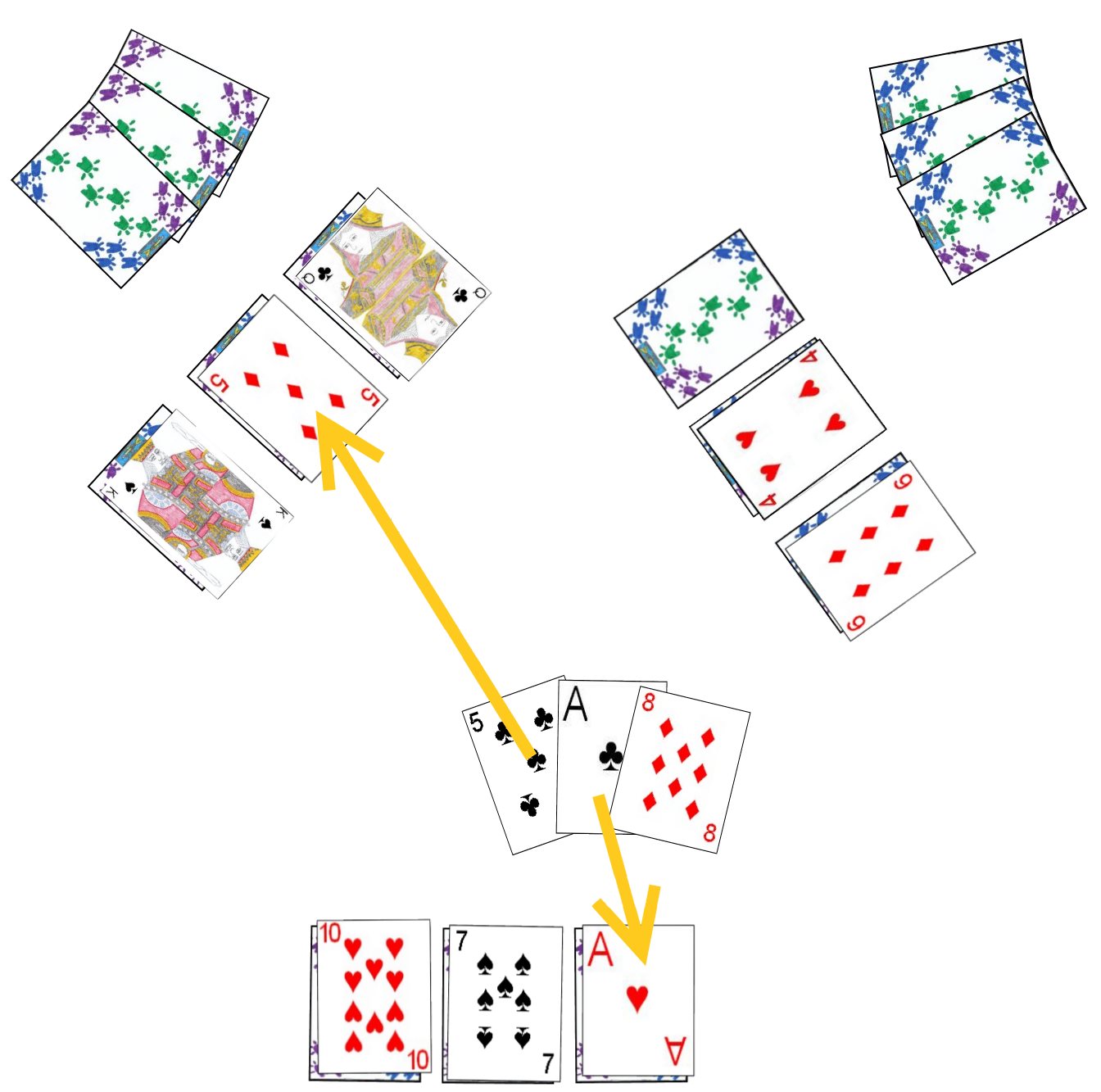Palace is a fun and fast-moving card game for 2 to 5 players. It is a favorite among travelers and backpackers, particularly across Europe, and, as a result, is known and played in many countries throughout the world. Due to the games International audience, this game is also known by a wide variety of other names such as Shed, China Hand,
Tens and Twos, and Ten-Two Slide.
The game is played using one standard 52 card deck. The ranking of the cards in this deck are as follows (from high to low); 2, Ace, King, Queen, Jack, 10, 9, 8, 7, 6, 5, 4, 3. Two's are considered special cards in this game and thus can really be
considered to be high or low.
A number of methods can be used to determine seating positions and first dealer, with drawing for high card a common method. The player drawing the highest card would take the first choice of seats at the table and become the first dealer. The player drawing the next highest takes any of the remaining seats and so on until each player is seated at the table.

|
| Sample initial game layout for the playing of Palace with four participants. |
Once the first dealer is determined he would then shuffle and offer the player to his immediate right to cut. After the cut, he then starts the deal. Cards are dealt in a clockwise direction around the table. The dealer would first deal three face down cards in a row in front of each player, one by one. After each player has these first three cards, the dealer would then deal three more cards to each player, placing these cards face-up and directly on top of the first row of three cards in front of the players. The dealer concludes by dealing three more face down cards to each player as his starting hand. He then places the remainder of the pack face down at the center of the table as a draw pile.
The players then pick up their three card hand for examination. After doing this, the players may then exchange cards between the cards in their hand and the face-up cards dealt in front of themselves. They may exchange any of these cards but need not exchange any if they do not want to. They may never exchange any of the originally dealt face-down cards, which remain face down until later in the game.
Once this is completed, play begins. The first player to have a face-up three (in a clockwise direction from the dealer) takes the first turn. If no player shows a three, the first player with a four exposed as one of his face-up cards has the first turn. If no player has a four showing face up, it continues with five and so on until the lowest card is determined, with that player taking the first turn.
The first player may select any card from his hand cards to play. If he has two or three of the same rank he may play all such cards. He places his card or cards to start a pile in the center of the table called the pick up pile. After making his play he draws one or more cards from the stock pile to replenish his hand to three cards. Play then proceeds in a clockwise rotation.
Each player in turn, then attempts to play a card or cards to the table that beats the current top card of the pick-up pile. If a player has multiple cards, all of the same denomination, that beat the card, he may play all of them.
After a player plays his card (or cards), he draws from the stock pile to replenish his hand to three cards (unless he already has three or more cards in his hand or the discard pile has been depleted in which case he just ends his turn).
If a player on his turn is unable to beat the last play to the pick-up pile, he must take the entire pick-up pile into his own hand, which also ends his turn. When this occurs, the next player in a clockwise rotation then starts play again, selecting any denomination card (or cards) of his choice.
During this phase of the game, the players may only play cards from their hand. However, once the draw pile has been depleted and a player has no remaining cards in his hand, that player may begin playing cards from his three face-up cards. These cards are played in the same way as if they were in the player's hand. If the player is forced to take the pick-up pile due to an inability to make a legal play on his turn, he must add the cards to his hand and must again play only from his hand until he again runs out of cards in his hand and may then resume play from his face up cards.
Similarly, once a player has played all three of his face up cards, he may then begin playing with his last three face-down cards. However, these cards are played blind and may not be looked at by the player before playing them. Thus, on his turn, he would simply flip any one of his face down cards. If the card is equal to or higher than the last card played to the pick-up pile, he adds that card to the pick-up pile and the turn moves to the next player. However, if the card is lower than the last play, he must take the face-up card and the rest of the pick-up pile into his hand. He must then resume playing with this hand until he depletes his hand, at which time he may again play any remaining of his face-down cards on his turn.
In addition, there are several special cards or situations that can be played on a player's turn:

- All Four:
If a player on his turn is able to legally play all four of a particular rank of card on his turn. This is called "burn the pack". When this occurs all the cards that currently make up the pick-up pile are set aside and discarded, not to be used again during the current hand. The same player may then start a new pick-up pile with a card of cards of his choice.
- Completing a Four:
If a player completes a four of a kind on his turn, by playing enough cards to the pick-up pile such that there are four cards currently on top of the pile of the exact same rank, this also "burns the pack". The entire pick-up pile is removed and the player who completed the four of a kind begins a new pick-up pile with a play of his choice.
- Tens:
A player, on his turn, may play a Ten at any time. This also has the effect to "burn the pack", removing the current pick-up pile from play of the current hand. The player who played the ten may then start a new pick-up pile with a play of their choice.
- Redraws:
If a player, after playing one or more cards to the pick-up pile, when drawing, obtains cards of the same rank as the card he just played, he may immediately also add these to the pick-up pile, if he can play them before the next player has yet made his own play to the pick up pile.
- Twos:
A Two may always be played to the pick-up pile by a player on his turn. This then resets the pile, which allows the next player in turn to make any play on top of the two.
Once a player completely runs out of cards (from his hand and his cards on the table), he is considered one of the game winners and drops out of the game. The game then continues until all players but one are completely out of cards, with that last player being declared the loser of the game. The loser is usually required to take the role of the dealer on the next game.
Additional Special Cards: One of the most common variants used with this game is changing the behavior of the currently used wild cards or giving special attributes to other cards in the deck. The most popular of these changes are as follows:
- Restricted Tens:
When this variant rule is used, a Ten can only be played when the last play was a nine or lower (a ten would have already cleared the pick-up pile). The ten still retains it's special capability to "burn the deck" and allows the player who legally plays it to take another turn.
- Out of Turn Fours:
In this variant, if a player is able to complete a four of a kind started by any other player he may immediately play these cards (even out of turn) to the pick-up pile to complete the four of a kind. This immediately "burns the deck" and allows the player completing the four of a kind to start another pick-up pile. The turn then resumes with the next player after the player who completed the four of a kind.

- Transparent Sevens:
When playing with this variant, one or more sevens may be played on any other card on the pick-up pile. The effect of the seven is that this card is, in essence, transparent and the next player must play a card to equal or beat the card played immediately before the seven. If the seven is the first card played to a new pick-up pile, the next player may play any card of his choice.
- Waiting on the Eight:
When this variant rule is used, the Eights are considered Wait cards. When a player legally plays an eight to beat the last card, the next player in turn misses his next turn.
- Jacks go Back:
This game is usually played in a clockwise turn direction. However, in this variant, a Jack played reverses the current direction of play. As most other cards, the Jack can only be played when it is higher or equal to the last card played to the pick-up pile.
- Crazy Nines:
In this variant the Nines are given a special feature. When a player legally plays a nine (to beat or equal the last play), the next player must play another nine or a card of a lower denomination than nine. Unless the next player also plays a nine, the card after the nine played must be beat or
equaled in the normal manner.
Palace - Multi-Deck: Palace can also be played using a double deck (two standard 52 card decks shuffled together). This is usually done to allow the game to be played by up to 9 players, but is sometimes done simply to allow a longer game. All rules of this version are identical except that up to 8 cards of the same type could be played on a players turn. When four or more cards of the same rank are played on a players turn, this allows the current player to burn the deck (discard the current play pile to the side) and the same player makes the first play to start a new pick-up pile.
Six Card Hand:
In some variations, the initial deal of the hand is performed somewhat differently. The first three cards are dealt identically to the standard game, three cards face down in front of each player which are not used of viewed until later in the game. However, difference arises on the next cards dealt. After the first three face down cards are dealt, the dealer then distributes six more face down card to form each player's hand.
After receiving their hand, the player then select three of these cards to be placed face up on his three face down cards. The remaining three cards are then used as his hand. After the deal, the game itself is played identically to the standard version described above.
No Finishing on a Special Card: In this variant a player is never allowed to, as his last play of the game, end with a ten or two. Thus, if a ten or two is the players only legal play, he must instead take up the current play pile into his hand. In the same way a players last card played may also never be an Ace.
Larger Hands: In games with two to four players, hands containing more cards are sometimes used. In this case, each player receives four face-down cards, four face up cards and a four card hand. At the end of his turn, a player would then draw enough cards from the deck to replenish his hand to four cards (until the stock was exhausted).
 Spanish Skitgubbe
Spanish Skitgubbe:
Spanish Skitgubbe is a Swedish version of Palace. This game is significantly different than the popular game simply called Skitgubbe. The rules for standard Skitgubbe can be found at this
link. Spanish Skitgubbe is played identically to Palace, as described above, with the following differences:
- Card Exchange
: After all cards have been distributed and the players have finished their own card exchanges, players may then add cards from their hands to their own or other players face up cards. The added card would be placed directly on top of the card of the same rank on a players layout on the table. This option may no longer be performed once actual play of the hand begins. In order to do, the cards must be of the exact same denomination. After doing so, they must then draw enough cards from the stock to return their hand to three cards.
- Draw Option
: In Spanish Skitgubbe, a player who is unable to beat or match the top card of the play pile may opt to "take a chance". He does this by drawing the top card of the draw pile and placing it face up on the play pile. If the card is a legal play (generally equal or higher than the current top card of the play pile), the card remains and his turn ends. The turn then rotates to the next player in turn. However, if the drawn card cannot legally be played to the play pile, the player must take the entire pile (including the newly drawn card) into his hand. A player is not obligated to "take a chance" and can instead simply take the current play pile, ending his turn. When the stock has been depleted, players obviously no longer have this option.
In all other aspects this version is played identically to the standard game of Palace detailed above.
Copyright © 2015 CatsAtCards.com. All rights reserved.



 Spanish Skitgubbe:
Spanish Skitgubbe is a Swedish version of Palace. This game is significantly different than the popular game simply called Skitgubbe. The rules for standard Skitgubbe can be found at this
Spanish Skitgubbe:
Spanish Skitgubbe is a Swedish version of Palace. This game is significantly different than the popular game simply called Skitgubbe. The rules for standard Skitgubbe can be found at this